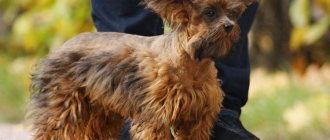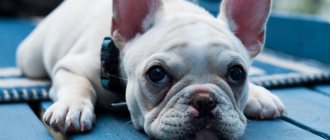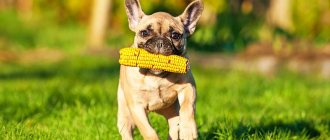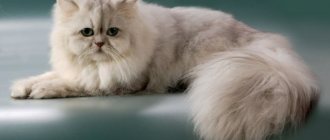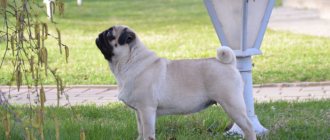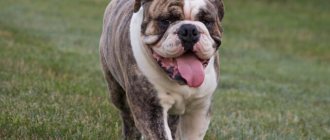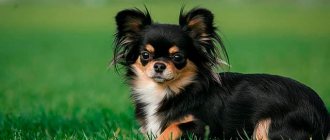The Petersburg Orchid dog breed appeared recently.
In 1997, Russian cynologist and dog breeder N. Nasibova developed a new breed of miniature indoor dogs, which in 2007 was included in the register of State-protected breeding achievements. The appearance of the breed was timed to coincide with the 300th anniversary of St. Petersburg, which, in fact, determined its name. It took 3 years to get a new breed of dog. Several miniature breeds were taken as a basis, the author does not disclose which ones. The “Petersburg Orchid” has not currently received recognition from international cynological associations. Dogs of this breed are known only in Russia.
History of the St. Petersburg Orchid breed
The idea of creating the breed belonged to Nina Nasibova, the owner of the S Lake Dolgoe nursery, which specialized in breeding Russian toys.
In the 90s, the breeder wanted to give the world a new variety of decorative dogs that combine external charm, but do not require complex grooming and specific care. As a result, the experiment was carried out with the participation of representatives of various toy breeds, which produced heterogeneous offspring in terms of further breeding. Work on the formation of the “orchid” phenotype continued for several years. Moreover, according to Nina Nasibova herself, most of the puppies born were given away for free, as they did not meet her expectations. It was possible to obtain the first individuals similar to today’s “Petersburgers” only in 1997. At the same time, information about the breeding sires used for mating was carefully hidden. According to one version, the owner of the nursery planned in this way to protect the breed from uncontrolled breeding by unscrupulous breeders. On the other hand, for commercial reasons and the desire to retain exclusive copyright.
One way or another, already in 2007 a patent was issued in the name of Nina Nasibova, and her charges received their registration number from the Ministry of Agriculture. So far, the St. Petersburg Orchid breed is in developing status, while at the same time, most of its representatives receive full pedigrees when sold. There is one more interesting nuance that limits the breeding of cute shaggy dogs: at the request of the breeder, mainly pet and show puppies are sold outside the Leningrad region, as well as abroad.
Brief historical background
The creator and author of this unique breed is a fairly well-known Russian breeder and dog handler N.P. Nasibova. She began developing a new breed line relatively recently; the idea of getting a small, cute lap dog, best suited for apartment conditions, was born in 1993, and in 1997 the first animals appeared. Several miniature dog breeds were used in the selection work, the list of which the author does not disclose in order to avoid fakes. Over several years of painstaking work, we managed to breed a small pet with the desired breed characteristics.
At the end of 2007, the breed under the official and original name “Petersburg Orchid” was included in the register of State protected breeding achievements in the section of domestic dogs. A patent and copyright certificate were issued. Currently, Nina Nasibova is the head and leader of the special-breed dog club “Petersburg Orchid”, she solely controls the breeding of the breed (exercises author’s control), all documents for the livestock are issued by her personally, certified by signature and seal.
The St. Petersburg Orchid breed was developed by breeder Nina Nasibova
The breed is not yet considered completely established; it is constantly being improved and improved. Selection work on the creation of new mixed-blood lines continues tirelessly, otherwise the breed will not be able to breed within itself without an influx of someone else's fresh blood from the outside. None of the international cynological associations currently recognize St. Petersburg orchids; these dogs are known exclusively on the territory of our country.
Breed standard St. Petersburg Orchid
Representatives of the breed are compact, elongated dogs that are distinguished by exemplary behavior at home, but love to be active during a walk, if one happens. There are standard (2-4 kg) and low-weight “orchids”, whose body weight ranges from 700 g to 2 kg. Little dogs look incredibly cute and are very popular, but due to anatomical features that complicate reproductive processes, they are never sold as breeding pets.
The height of an adult St. Petersburg orchid is up to 30 cm at the withers, so all individuals that have crossed this barrier are considered plembrac. The minimum height limit for a dog is 17 cm. Sexual dimorphism in the breed is very weak, which greatly facilitates the choice of a pet if only the exterior characteristics of the dog are important to the potential owner.
Head
The rounded skull of the St. Petersburg orchid fits well into the square shape. The dog's light, dry head is distinguished by its straight contours and medium size. Mandatory breed condition: the length of the muzzle must be at least ⅓ of the length of the head.
The faces of St. Petersburg orchids may be slightly pointed in the nose area, but the classic narrowed shape is not typical for them. The stop is distinct without being overly sharp, and the under-eye area is well filled. The line of the muzzle is always parallel to the frontal line.
Lips and teeth
The lips are dry rather than fleshy, fitting closely to the teeth. The teeth are small, forming a scissor-shaped bite in the bow. It is always preferable to have a complete dental formula.
Nose
The lobe is very small, matching the color of the main color or a rich black tone.
Eyes
The eyes of the St. Petersburg orchid have a straight and wide fit with a very dark iris color. The eyelid section is oval-almond-shaped.
Ears
The medium-sized ears have rounded tips and hang spectacularly on cartilage. The ear flap is evenly covered with hair.
Neck
The long, distinctly dry neck is characterized by a slight bend.
Frame
The bodies of St. Petersburg orchids are elongated, having an elongation range of 106-108. The moderately convex withers are continued by a straight line of the back, forming a convex zone only in the lumbar region. The wide croup is characterized by a barely noticeable slope with an angle of inclination from 15 to 30°. The chest is distinguished by normal depth and good width for a decorative dog. The stomach is strongly tucked.
Tail
Tail docking is allowed. If the docking procedure was not carried out, the tail takes the shape of a saber, or less often - a ring.
Limbs
The length of the legs of the St. Petersburg orchid is ½ of its height (at the withers). Parallelism and straightness of the forelimbs are mandatory breed characteristics. The shoulder angles range from 90 to 110 degrees, the elbows are close to the sides of the dog, and the pasterns are vertical. The hind legs of "orchids" are held parallel, showing well-defined articulation angles and steep metatarsals. The paws are small, in a ball. The movements are fast, with parallel extension of the limbs and a good push.
Color
Formally, the St. Petersburg orchid can have fur of any color except white. At the same time, the palette of permitted colors is replenished from time to time with some new “specimen”. The most common breed colors today are:
- brindle (graded from red to gray);
- all variants of red;
- black and tan with tan from light gray to brick red;
- fawn;
- black;
- cognac;
- cream rose;
- chocolate and tan;
- chocolate;
- zonal in different tones;
- lilac;
- blue;
- silver
Acceptable features include small white markings on the chest, paws and muzzle. The presence of masks on the faces and so-called belts on the backs of animals is regarded as a normal exterior phenomenon.
Wool
The guard hair is quite long, soft and much larger than the undercoat. In some individuals, the fur has a slightly wavy structure. For all representatives of the breed, a special type of haircut has been developed, which is called orchid. The peculiarity of grooming an animal is that the hair on its back and neck is removed in the same way as that of a cocker spaniel. The mustache, beard, bangs and ears remain covered with a layer of soft hair. Also, the hair is cut from the knuckles, and the hair on the lower body and sides is styled into a full skirt.
Important: not long ago, a short-haired variety of the breed appeared, called the Neva Orchid. Neva dogs look a little less glamorous than their shaggy relatives, but they do not need a haircut.
Characteristic
There are breeds that have been known to man for a long time, and there are those that have recently appeared. The St. Petersburg orchid belongs to the second type, since it was recognized only since 1997.
This mini-dog was bred in St. Petersburg, hence the name. To get a dog with an exceptional exterior, breeder Nina Nasibova needed to use several breeds of dogs for crossing:
- chihuahua;
- toy poodle;
- Yorkshire Terrier;
- lap dog.
The woman did not immediately achieve the desired result; she had to spend a lot of time on the work. Only three years after the crossing, animals were born that were distinguished by their bright appearance and wonderful character. The appearance of the new breed was timed to coincide with the 300th anniversary of St. Petersburg.
Today there is a detailed description of this Neva breed, which can be used to determine whether the puppy meets the selection requirements or is defective. Generally speaking, small dogs have a stretched body, small muscle mass and medium bones.
Upon closer examination, it is difficult not to notice the pronounced sexual dimorphism, which is manifested both in the appearance of the animal and its behavior. Among the advantages, the breeders especially highlighted the dog’s appearance. The fur falls in waves down from the spine. On the front of the muzzle there is a bang, which is ideally complemented by long ears.
Individuals of the described breed do not grow more than 300 mm at the withers. Weight can vary from 2.5 to 4 kilograms. It is dangerous when the female St. Petersburg orchid weighs less than 1.5 kg. The lack of weight means that she will not be able to give birth on her own.
Inside the finished standard, the dogs are described in more detail. The head is small in size, characterized by rectangular lines. The muzzle is shorter than the head - on average a third of its dimensions; it becomes slightly pointed towards the end.
The transition from the forehead is clearly visible, but not sharp. The nose is black or colored in a different shade to match the color of the dog's fur. The lobe is small.
Representatives of the breed have small, oval-shaped eyes, which are located at a great distance from each other. The look is meaningful. The breed is not bug-eyed.
The ears stand high, hang down, but are small. Fits well with head sizes.
When examining the teeth, the bite must be correct and scissor-shaped. The jaw is formed by small but rather sharp teeth.
The neck is dry, slightly elongated, characterized by a slight bend. A straight line is visible on the back. She is quite wide and muscular. You can easily see the withers, which smoothly flow into the lower back. The chest is deep, the stomach is retracted.
The paws are thin, positioned evenly, absolutely parallel to each other. The tail is located below the back; it can be trimmed according to the breed before the animal grows. With proper docking, 2-3 vertebrae are left. If left long, it may stick out straight, or it may curl.
Special attention is paid in the description of the wool breed. It is not only long, but also thick, sometimes falling slightly in waves. There is a separate subspecies - shorthaired
This is the Neva orchid
There is a separate subspecies - shorthaired. This is the Neva orchid.
As for color, there is no clear definition. Any color is allowed, only white is missing according to the description. There are individuals with a single color, and there are multi-colored ones.
Dogs and the following colors stand out from the crowd:
- brindle;
- muruga;
- black with tan.
Burn marks can also be of different colors. The most common colors are red, cognac-colored, smoky, gray and yellow.
The overall tone of the coat can vary greatly. If these dogs are red in color, then it is not always the same, it varies from light wheat to dark, as close as possible to cognac.
There is red wool. The palette is quite wide. You can see a representative of the breed with a shade of creamy rose or dark burgundy with a little blackness.
You can find representatives of the breed that are silver or even blue. They look very interesting and unusual.
The creator of the breed continues to work on breeding dogs with other coat colors. There are plans to get bright representatives of the St. Petersburg orchid with spotted colors, white and red, or even black and white.
If you provide proper care and nutrition to the dog, then it lives in a house with its owners for about 14 years, which is quite a long time
It is important to ensure that the dog does not jump from a great height, since the animal’s skeleton is very fragile, such a fall can cause a dislocation or fracture, and bruising of internal organs is often observed. As a result, the pet's lifespan is reduced
Character of the St. Petersburg orchid
When creating the breed, attention was focused on developing in its representatives those qualities that would allow them to become ideal companions for residents of the metropolis. As a result, St. Petersburg orchids turned out to be comfortable in all respects and the most urbanized pets. These glamorous kids are never sad, radiating round-the-clock positivity, and they are equally willing to frolic on a walk and sit on the sofa in front of the TV in company with their owner.
Despite their almost dwarf dimensions, St. Petersburg orchids are not at all cowardly and have a consistent character. They are not characterized by nervous tantrums and barking “just because they’re bored,” but they get along well with all representatives of the domestic fauna. Accordingly, if you need a dog that will find a common language with your independent cat, it’s worth taking a closer look at the “orchid”.
Indiscriminateness in expressing feelings of affection is a trait that was purposefully developed in representatives of the breed. The St. Petersburg Orchid is that rare type of dog that equally loves, respects and obeys all family members. Moreover, these stylish kids are very trusting, so they are ready to jump into the arms of any person who enters the house. As for guard skills, “orchids” are not outsiders in this field either. Of course, such a tiny “tail” is not able to scare an intruder, but it will be ideal for spreading the news that someone else is trying to break into the apartment.
Another interesting behavioral trait of the breed is the ability to adapt to the pace of life of the owner. Breeders assure whether a dog will grow up to be a darling of the sofa or become a flamboyant fidget depends only on the person. The “orchids” themselves perceive quite normally both a passive lifestyle and its opposite version.
Education and training
St. Petersburg orchids are celebrities of the dog world, who more often sit under the arms of their owners at social events than run along the paths of parks. For this reason, classical training for the breed is not as important as good education. Fluffy “St. Petersburgers” are smart, curious and willing to learn everything new, but only if the owner did not waste time and organized the learning process correctly. The most common mistake in raising a St. Petersburg orchid is connivance and the hope that such a small pet is simply not able to ruin the owner’s life. Believe me, I still can. From the first days of life, take care of the animal seriously, but without being too harsh: remember, the breed was bred for love, not for drilling.
Typically, St. Petersburg orchids are given to new owners when they have grown up and have mastered basic behavioral rules. For example, representatives of this breed very quickly understand how to properly go to any toilet, from the tray to the diaper, and do it earlier than other puppies. Also, don’t be lazy to accustom your pet to walking on a harness: of course, you can carry the animal on the street and in your arms, but this is not entirely convenient, and it’s always useful for the “orchid” living in the apartment to run around. Mandatory commands that must be taught to a decorative dog are “Come to me!” and “You can’t!” Thanks to the first, it is convenient to control the pet’s behavior, and the second will help in stopping unwanted actions, especially when it comes to picking up conditionally edible objects on the street, which is typical for all four-legged pets.
Do not allow the puppy to argue with you, namely: growl, pull toys out of your hands with his teeth, or demonstrate disagreement with demands by biting your fingers. Of course, the tiny dog will not cause physical damage to his health, but gradually he will develop an extremely unpleasant pattern of behavior. For the same reason, the dog must know its place in the house. Even if you love it when the “orchid” sleeps peacefully next to you on the sofa, try to arrange a separate corner with a basket for it, not forgetting to practice the “Place!” command. and periodically use it when the pet intrudes into personal space too intrusively.
You won’t have to compete for leadership status with St. Petersburg orchids, but the animal still needs to show who’s boss in the house. The easiest way to do this is to feed your pet after people have eaten dinner. At the same time, no tasty compensation is offered to the four-legged prankster during the feast. This approach will help the fluffy dog quickly and correctly fit into the hierarchical family system, since the psyche of St. Petersburg orchids is the same as that of most dogs.
Basic moments
- The breed is not recognized by international canine associations and continues to be formed exclusively through the efforts of the Russian breed club called “Petersburg Orchid”.
- The main population of St. Petersburg orchids lives in Russia. Single individuals, mainly of the pet class, are exported abroad.
- The name of the breed was not invented by chance: the image dogs were bred in the city on the Neva on the eve of the celebration of its 300th anniversary.
- The St. Petersburg orchid is the best pet for homebodies, since representatives of this family do not need to be walked.
- Unlike other decorative dogs, standard St. Petersburg Orchid females do not have difficulties bearing and giving birth to offspring. According to the rules of the breed club, individuals who have had to undergo a caesarean section at least once are no longer allowed for breeding.
- St. Petersburg orchids have no problems in terms of livability and easily share territory with other dogs, cats and even rodents.
- The breed rarely uses its voice and only when necessary, so silence in the house where such a dog lives is guaranteed.
The St. Petersburg orchid is a small, shaggy piece of happiness, whose cute appearance evokes a feeling of sincere tenderness and a desire to gently cuddle its owner. The breed was bred as an image-companion breed, so its representatives live only in apartments, and appear at social events and on social networks more often than on walks
It’s not difficult to attract attention if you have an “orchid” under your arm – most Russians are still not aware of the existence of such dogs. It’s true that there is no point in being overly ambitious.
It will not be possible to travel to exhibitions and collect champion diplomas with St. Petersburg orchids due to the fact that the breed has not yet been standardized by any canine federation.
Maintenance and care
In interviews with breeders about the breed, the emphasis is always on the unpretentiousness of its representatives in terms of care. But don’t take this information literally – you won’t be able to ignore the dog’s image at all. Like any decorative pet, the St. Petersburg orchid urgently needs hygiene procedures with professional cosmetic products and light grooming.
The classic care regimen is washing the wool with shampoo that prevents the formation of tangles, followed by the use of special conditioning compounds. After such products, the spine becomes smoother and does not become tangled, and a dog washed in this way can not be combed for a whole week. A breed-specific haircut that allows you to fully reveal the exterior potential of the “orchid” only looks complicated. In fact, it is easy to do it yourself, without resorting to the services of a groomer.
A pleasant bonus for all fans of the breed is the absence of seasonal shedding among its representatives. So if you prefer cleanliness, but don’t like picking up tufts of wool from carpets, St. Petersburg orchids are right up your alley. Of course, during the life of an animal, the hair of the animal periodically dies off, but if the owner does not neglect to comb the pet, there will be no scraps lying around the apartment - they will all remain on the comb. It will not be possible to avoid cleaning the ears and eyes of St. Petersburg orchids, but since this process is simple, it will not take much time. It is enough just to buy a hygienic lotion that softens the wax in the ear cup, and for the eyes use a clean cloth moistened with a decoction of chamomile flowers.
Feeding
St. Petersburg orchids are partial to standard dog treats, but they do not suffer from gluttony. A tendency towards obesity in representatives of the breed has also not been identified, so there is no need to weigh out the daily amount of food on a scale. According to N. Nasibova herself, “orchids” are able to live their entire lives on “drying”, which will not cause any damage to their health. The only obligatory condition is that the food must be of high quality and at least super-premium.
At the same time, the creator of the breed keeps her producers on the so-called species-specific diet, which implies a complete rejection of heat treatment of products. According to the breeder, this approach has a positive effect on the health of the animals’ teeth - “St. Petersburg residents” who eat natural food do not suffer from tartar, and their breath is always fresh.
So, what do the dogs eat in Nina Nasibova’s kennel? First of all, raw lean meat and offal. Once a week, adult St. Petersburg orchids are offered a fish fillet - hake, pollock, cod or sea bass, as well as one raw quail egg in the shell. In this case, cereals are completely excluded from the diet. Vegetables, fruits and young greens enter the animal’s bowl only in raw and finely chopped form. Usually, over time, dogs develop their own favorite types of plant foods. For example, some individuals respect fruits more, others are delighted with tomatoes and carrots. It is not recommended to try to change the taste preferences of the “orchid” - leave the freedom of choice to your pet.
Important: Be very careful when introducing chicken and chicken waste into your diet. St. Petersburg orchids that eat this type of meat for a long time may begin to have watery eyes and dandruff.
Adults are fed twice a day. Usually the food intake is determined by eye, depending on the pet’s physical activity. The creator of the breed recommends placing a bowl of lunch in front of the puppy and allowing no more than 10-20 minutes for the feeding process. If the dog has finished eating before, next time the portion can be slightly increased. If, on the contrary, you haven’t finished eating, then put less food in the bowl.
Cartilage, flat bones and chicken heads, as well as fermented milk products will help cover a growing dog's need for collagen and calcium. As for pharmaceutical dietary supplements, the appropriateness of their use is determined by the owner. Nina Nasibova recommends choosing natural food supplements, focusing on the fact that all the dogs in her kennel do without synthesized vitamins and give excellent offspring.
Health and diseases of St. Petersburg orchids
Since the breed continues to form, and its creator does not stop breeding experiments, it is extremely difficult to identify the pattern of development of genetic diseases in animals. It is reassuring that the breeder conducts a strict culling of puppies and sires, mating only between completely healthy individuals, which allows them to obtain healthy offspring. Separately, it should be noted the low-weight “orchids”, which, like most dwarf breeds, have an extremely fragile constitution and cannot independently produce offspring. When taking such a dog into your home, be prepared to create a safe environment for it - mini-dogs get injured very easily.
Medicinal properties
One of the reasons for the disappearance of the population of northern orchids is their medicinal properties. For example, young Orchis roots, also called salep tubers, are very widely used for medicinal purposes. The tubers are dried and a white powder called salep is obtained from them, which is used to treat many diseases.
Salep tubers have been used for medicinal purposes since ancient times.
The common slipper is used as a good sleeping pill and sedative. Lyubka bifolia has been used since ancient times to treat impotence.
Important! Of the large variety of orchids, about 4000 are used for medicinal purposes.
How to choose a puppy
- Choose your breeder and nursery carefully. Please note that permits for breeding St. Petersburg orchids are issued only by Nina Nasibova’s club.
- It is not recommended to take small puppies (up to 2 kg) into families with children, since an overly miniature animal is more easily injured due to careless handling.
- When selling their wards, official nurseries issue a whole package of documents, which should also include a puppy club card, personally certified by N. Nasibova.
- All purebred “orchids” must have a brand tattoo located in the groin area. The number of the brand and the animal's puppy metric must match.
- Find out how many puppies were in the litter initially. It’s great if there were no more than 3-4 kids. In litters that are too large (St. Petersburg orchids bring up to 7 puppies), animals often do not have enough mother's milk, which negatively affects their immunity.
- The cost of a puppy largely depends on its color. The most popular and expensive colors of the breed are chocolate, brindle, cognac, bright red with black.
- If you want an animal from N. Nasibova’s personal nursery, find the VKontakte page of the breed’s creator to arrange a meeting and get information about the breed from a person who knows everything about it. There you can also see a list of nurseries that have official permission from the club to sell St. Petersburg Orchid puppies.
Walk
A dog of the St. Petersburg Orchid breed does not need constant walking, but taking it out into the fresh air is recommended for physical activity and the prevention of obesity. Immediately while the puppy is small, you need to introduce him to a leash and collar. The dog must understand that he is led by his owner, and not vice versa.
Note! In crowded and possibly risky places, it is worth taking the baby in your arms. When walking a dog, you need to pay attention to the fact that other animals can offend it: not only relatives, but even cats.
Price of St. Petersburg orchid
A pet-class dog with an official package of documents from the breed club will cost 40,000 rubles. St. Petersburg orchids, which fit into the super-mini format, are more expensive. As for breeding individuals, it is quite difficult to get them, unless you are a breeder with experience and exhibition awards. The author of the breed is very sensitive to the breeding of animals, preferring to personally control all matings and selection of breeding pairs, therefore, in the vast majority of cases, potential breeders are from breeders living in the Leningrad region.
